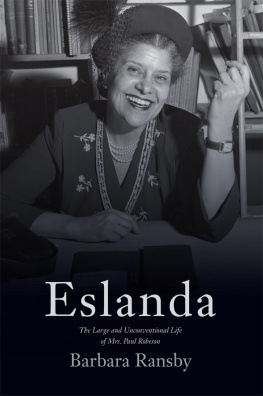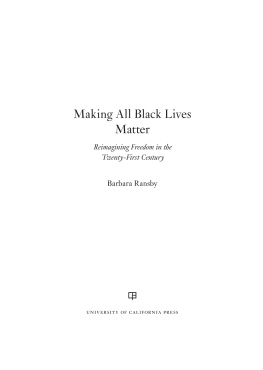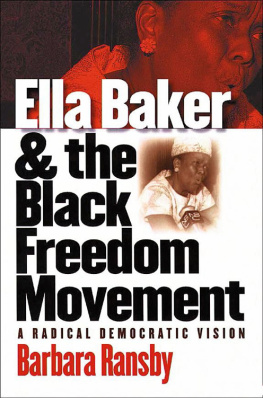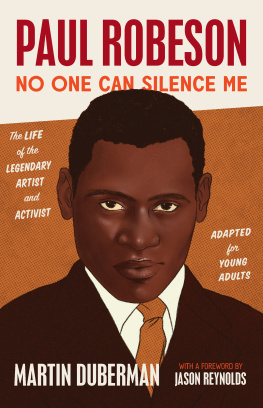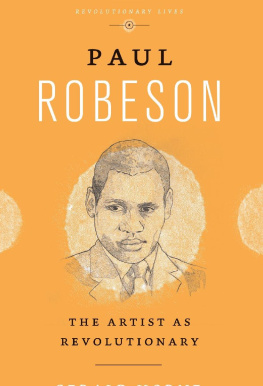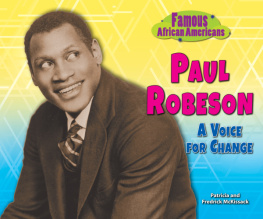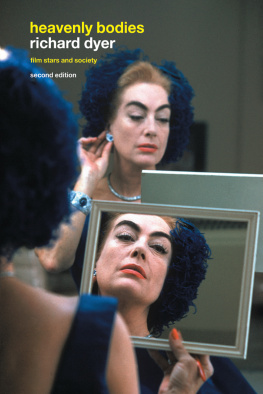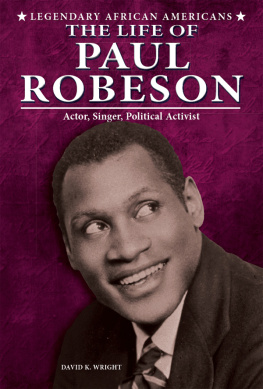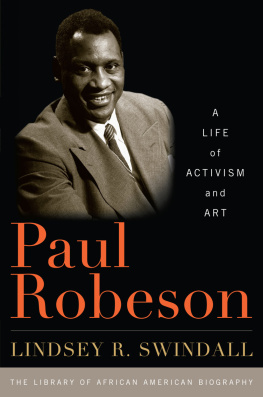Barbara Ransby - Eslanda: The Large and Unconventional Life of Mrs. Paul Robeson
Here you can read online Barbara Ransby - Eslanda: The Large and Unconventional Life of Mrs. Paul Robeson full text of the book (entire story) in english for free. Download pdf and epub, get meaning, cover and reviews about this ebook. year: 2022, publisher: Haymarket Books, genre: Politics. Description of the work, (preface) as well as reviews are available. Best literature library LitArk.com created for fans of good reading and offers a wide selection of genres:
Romance novel
Science fiction
Adventure
Detective
Science
History
Home and family
Prose
Art
Politics
Computer
Non-fiction
Religion
Business
Children
Humor
Choose a favorite category and find really read worthwhile books. Enjoy immersion in the world of imagination, feel the emotions of the characters or learn something new for yourself, make an fascinating discovery.
- Book:Eslanda: The Large and Unconventional Life of Mrs. Paul Robeson
- Author:
- Publisher:Haymarket Books
- Genre:
- Year:2022
- Rating:3 / 5
- Favourites:Add to favourites
- Your mark:
- 60
- 1
- 2
- 3
- 4
- 5
Eslanda: The Large and Unconventional Life of Mrs. Paul Robeson: summary, description and annotation
We offer to read an annotation, description, summary or preface (depends on what the author of the book "Eslanda: The Large and Unconventional Life of Mrs. Paul Robeson" wrote himself). If you haven't found the necessary information about the book — write in the comments, we will try to find it.
Barbara Ransby: author's other books
Who wrote Eslanda: The Large and Unconventional Life of Mrs. Paul Robeson? Find out the surname, the name of the author of the book and a list of all author's works by series.
Eslanda: The Large and Unconventional Life of Mrs. Paul Robeson — read online for free the complete book (whole text) full work
Below is the text of the book, divided by pages. System saving the place of the last page read, allows you to conveniently read the book "Eslanda: The Large and Unconventional Life of Mrs. Paul Robeson" online for free, without having to search again every time where you left off. Put a bookmark, and you can go to the page where you finished reading at any time.
Font size:
Interval:
Bookmark:


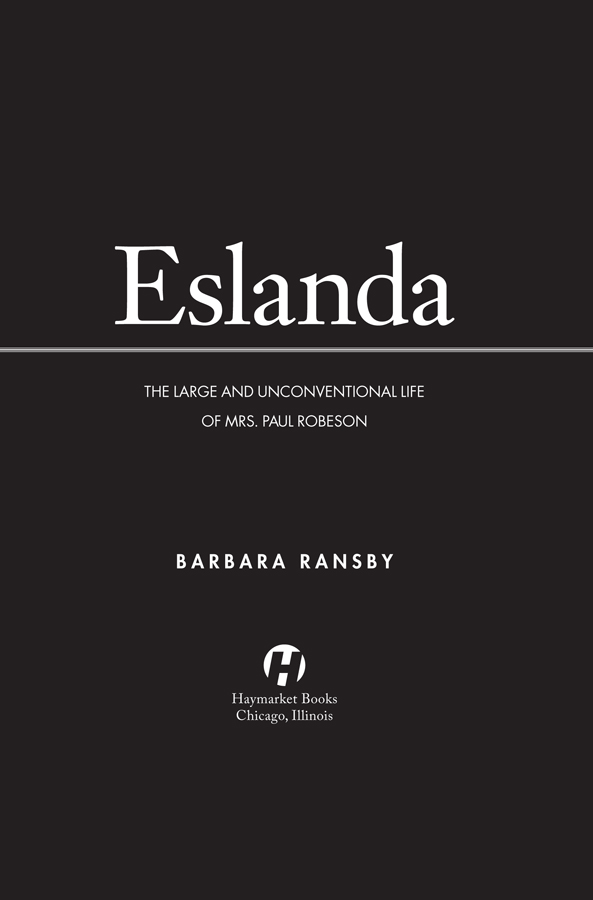
2022 Barbara Ransby
First published in 2013 by Yale University Press with assistance from the foundation established in memory of Amasa Stone Mather of the Class of 1907, Yale College.
Published in 2022 by
Haymarket Books
P.O. Box 180165
Chicago, IL 60618
773-583-7884
www.haymarketbooks.org
ISBN: 978-1-64259-679-3
Distributed to the trade in the US through Consortium Book Sales and Distribution (www.cbsd.com) and internationally through Ingram Publisher Services International (www.ingramcontent.com).
This book was published with the generous support of Lannan Foundation and Wallace Action Fund.
Special discounts are available for bulk purchases by organizations and institutions. Please call 773-583-7884 or email for more information.
Cover photograph of Eslanda Robeson taken in 1952 by Hyman Rothman, published by permission from NY Daily News Archive via Getty Images.
Cover design by Rachel Cohen.
Library of Congress Cataloging-in-Publication data is available.
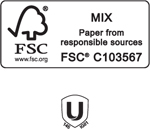
For Peter, Jason, and Asha
PREFACE
Since the publication of Eslanda: The Large and Unconventional Life of Mrs. Paul Robeson in 2013, I have spoken to thousands of people in audiences all over the world about this tough, tenacious, and fascinating woman. Eslanda Cardozo Goode Robeson died in 1968, as Africa was emerging from the yoke of colonialism and the rest of the world felt on the verge of revolution. She was proud of her decades of crusading for racial justice and African independence. She knew in 1968 that the work to which she had devoted her life was far from done. Alongside her husband, colleague, and comrade, the acclaimed artist Paul Robeson, Eslanda allied herself with the struggle against imperialism, capitalism, and white supremacy from the 1930s on. She was also uncompromising in her resistance to the McCarthy-era repression that almost destroyed her family and her husbands career. In her own way, she was also a feminist, paving a career path as a journalist, activist, and anthropologist, and establishing a political voice that was all her own. She allied with and advocated for womens rights wherever she went.
Eslanda was a world traveler. She moved across the planet not as a tourist but as an act of solidarity: to the front lines of the antifascist forces in the Spanish Civil War; to Uganda as a respectful researcher; and to meetings in Ghana, China, Russia, Guyana, London, and New Zealand. To her mind, she was born a Negro American woman and became a Black global citizen. She forged strong relationships throughout the African continent and beyond, establishing herself as a pathbreaking Black woman internationalist. She wrote, spoke, worked, and lived in the venerable and rich Black radical tradition, a tradition that continues to this day.
In the mid- to late twentieth century, groups like the Black Panther Party and the Student Non-Violent Coordinating Committee and the Black feminist internationalists like June Jordan, Angela Davis, and Eslandas friend and contemporary Claudia Jones were exemplars of this tradition, expressing principled solidarity with peoples struggles for freedom all over the world.
I have had the honor to work closely with the Movement for Black Lives (M4BL) coalition for the past several years. It is one of the largest coalitions of contemporary Black freedom movement formations in the U.S. today. Very much in Eslandas tradition, Black internationalism has been central to M4BL since its inception. Several delegations have gone to Palestine, and statements were crafted in solidarity with the peoples of Tigray, Sudan, Haiti, and Cuba. A Haiti material aid campaign was launched, and solidarity projects with African Diasporic communities in Brazil and southern Africa have been hallmarks of M4BLs internationalist praxis. Eslanda would have been proud.
As for me, I take Eslanda with me wherever I go. I spent many years digging into the corners and crevices of her life and came to respect her greatly for what she accomplished, as much as I was humbled by her mistakes and contradictions. Since 2013 the world has changed greatly. We saw the election of a proto-fascist maniac to the White House and witnessed explosions of protest in the United States and around the world. After the murder of an unarmed Black man in Minneapolis in 2020, more than twenty million protesters flooded the streets across the United States. We also endured a global pandemic that reminded us with acuity of our interconnectedness and interdependency, and the precarity of our very existence.
When I move around the world and when I map my own sense of obligations and commitments to global justice, I continue to be inspired by Eslandas bold curiosity, her staunch loyalty to the dispossessed of the world, her uncompromising spirit, her refusal to be silent about what she knew, saw, believed, and felt, and the way her fierce confidence coexisted with her humility. Those of us in the U.S.-based Black freedom movement and a part of Black internationalist and Black left feminist traditions are challenged to embrace and, to the degree possible, match her example. The bar is set and the stakes are high. Her life is but one more example that what we do matters, standing on the right side of history matters, and a life of consistent praxis helps to change the world. She is in good company: Ella Baker, Toni Cade Bambara, Claudia Jones, Fannie Lou Hamer, Marielle Franco, Lorraine Hansberry, Olive Morris, Shirley Graham Du Bois, Funmilayo Ransome-Kuti, and others.
The relationship between a biographer and her subject is a unique one. My experience with Eslanda, Ella Baker, and the women whose activism I wrote about in my most recent book, Making All Black Lives Matter, are special to me. I had the privilege of delving into their lives, and they, in turn, changed mine. I once gave a talk about Ella Baker called A Conversation between Sisters, Living and Dead. I feel biography and movement narration is a kind of intergenerational conversation that touches, shapes, and changes the participants. I think Eslandas influence on me has been to push me to resist parochialism or nationalism in my view of the world and in my view of Black struggle. I will always appreciate that about her.
In thinking about the preface to this special Haymarket edition of this book, nearly ten years after Eslanda was launched into the world, I think of how my relationship with the subject has evolved, and what her legacy means to all of us today. Since Eslanda was a devoted diarist and diligent letter writer, I thought of how might I craft a letter to her from the vantage point of 2022, more than a half-century after her death. I would tell her this.
Essie, my dear... The bad news is the world is still a mess! Black people are still fighting for our freedom, and up against some nasty and violent opposition. You would have cheered on the many young people who took to the streets in Ferguson, Missouri, and in Minneapolis, Chicago, and Baltimore to protest racist police murders. New coalitions and networks of resistance are being created as a result of the intense times in which we are living. There are women like you, all over the world: women who refuse to be silenced or sidelined. And while the independence struggles of the mid-twentieth century did not win the robust, full-bodied freedom that you and so many had hoped for, the African Diasporaon the continent of Africa and beyondis still a cauldron of resistance. This phase of struggle is resistance to neocolonialism and neoliberalism, to corruption by new elites and collaborations with old ones. There are eloquent young voices speaking out against the pillage and polluting of the land and water. There are labor struggles and student protests and womens campaigns. The radical tradition of Black womens resistance continues! Your contributions remind us that each phase of struggle and each generation confronts its own challenges, but the struggle perseveres. Thank you for your provocative and inspiring example.
Font size:
Interval:
Bookmark:
Similar books «Eslanda: The Large and Unconventional Life of Mrs. Paul Robeson»
Look at similar books to Eslanda: The Large and Unconventional Life of Mrs. Paul Robeson. We have selected literature similar in name and meaning in the hope of providing readers with more options to find new, interesting, not yet read works.
Discussion, reviews of the book Eslanda: The Large and Unconventional Life of Mrs. Paul Robeson and just readers' own opinions. Leave your comments, write what you think about the work, its meaning or the main characters. Specify what exactly you liked and what you didn't like, and why you think so.

